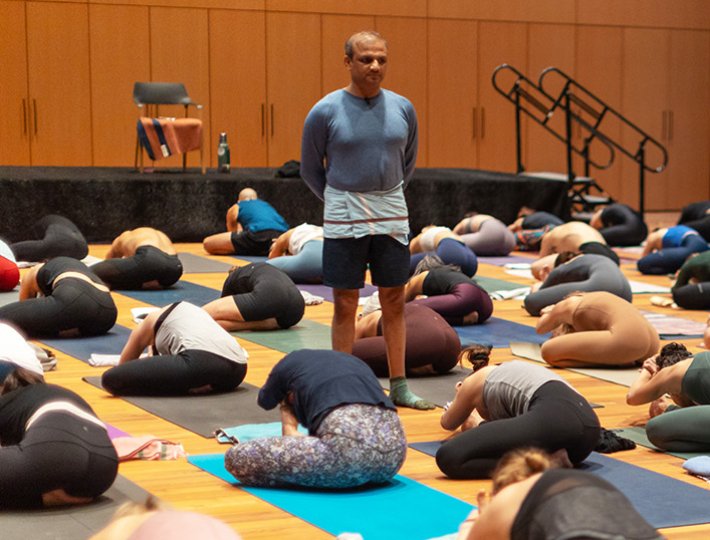Watch someone sweat through strokes on an indoor rowing machine and you might think the activity is akin to any other gym cardio workout, such as Spinning or treadmill running, which require a lot of heart-pounding effort on a road to nowhere. Or you might think it looks like an upper-body exercise, as the arms pull the handle back with each movement and the rest of the body sits and takes a ride. You may have even sat down on an erg at some point and come to these same conclusions.
If so, there’s a lot more to it than you realize. When done properly, rowing is a surprisingly calming and invigorating routine that challenges the whole body without the wear and tear that come with other intense activities. It’s also an excellent fat-burning exercise, according to a new study published in June in the Scandinavian Journal of Medicine and Science in Sports, which compared fat oxidation during rowing and cycling at various intensities. Rowing consistently won out thanks to the recruitment of larger muscle mass on the erg.
So how is such a challenging workout also considered calming and restorative? During a rowing session you should spend more time on recovery than all-out effort, to the tune of a 2-1 or 3-1 rest-to-work ratio, according to Eric Von Frohlich, the co-founder of Row House, an indoor rowing studio in New York City with a new location in Chelsea. In other words, if you pull back for one second of explosive effort, you’ll spend two or three seconds recovering as you exhale and return to start in a controlled, fluid motion.
This steady yet powerful movement is key as it ensures a work pattern that’s sustainable for a long session and maximizes fitness benefits. “With that 1-3 recovery ratio you can get a lot of power and a little breath, or rest, in each stroke. You get a lot of fitness effort but you don’t burn out,” says Debra Strougo Frohlich, the co-founder of Row House.
Physiologically you activate a lot more muscle rowing than you do in just about every other form of cardio. “It’s in a category of cross-country skiing or swimming as a full-body exercise,” says Von Frohlich. “Each stroke should be driven 60 percent by the legs and 30 percent by the core, and then it’s being finished with the arms. It’s a lot like jumping, but instead of a vertical component it’s in a horizontal movement.”
Related: How Setting an Intention Can Transform Your Workout
The mechanics of the motion break down like this: Start on the erg with the knees bent, fingers lightly hooked around the handle, and torso tilted slightly forward at 11 o’clock. Exhale as you explode back, first through the legs, then the abs, and finally bringing the handle back just below the sternum, with elbows naturally at the sides of the body and torso coming to 1 o’clock. On the return, take the reverse course and exhale as the arms move forward, followed by the torso, and finally bending the knees. This steady pattern combined with breath and the swooshing of the machine makes the activity almost like a meditation or breathing exercise.
In addition to being mentally calming, it’s also accessible to those new to exercise, partially thanks to the low center of gravity on the erg, which is helpful for anyone who has physical challenges, weight issues, or anything that inhibits them from moving as well as they’d like, says Von Frohlich. It’s also ideal for marathon runners seeking the intensity and volume of exercise without the wear and tear.
Another important benefit rowers experience is better posture and less pain. “Most of our days are spent in forward flexion, whether you are a new mom or work in an office. If you think about how people traditionally work in an office setting their shoulders roll in, their hands are up—that’s all internal rotation that tightens the shoulders, closes the chest, tightens the abs, and overstretches the back,” says Von Frohlich. This leads to postural imbalances and problems with the neck, upper back, and shoulders, as well as tight hips, psoas, and piriformis. Rowing makes you feel a lot taller and more conscious of posture; the shoulders pull back and the body opens up. That’s such a huge benefit—if that were the only upside you could make a great case for it.
Related: Your Body in Downward-Facing Dog
Interested in trying out a rowing workout? The following routine based on the Row House Full Body class is a good place to start.
Warmup: Row at a moderate pace for 5 minutes
Stroke Ladder (3 to 5 minutes): Incrementally increase and then decrease strokes per minute (SPM) in the following pattern 24-26-28-30-28-26-24. (You’ll spend about 30 seconds at each SPM.)
Power Strokes (3 to 5 minutes): Do 2 rounds of 10, 15, and 20 powerful strokes, keeping stroke rate consistent and working to bring down split time. Start with one minute of 10 power strokes then do 10 light strokes. Move on to 15 power strokes at the same SPM, and attempt to bring down split time. Recover for 15 light strokes. Now do 20 power strokes, aiming for the same SPM and a lower split time. Repeat this pattern of 10, 15, and 20 strokes again.
Go the Distance (4 minutes x 2): Row for 4 minutes and note how many meters you go. Recover, then go the distance for another 4-minute spurt and attempt to go farther this time.
Off-Rower Exercises (7 minutes):
Lower Body (30 seconds each): Forward lunges, side lunges, reverse lunges, air squats, and squats with calf raises
Core Work (30 seconds each): Forearm plank with small alternating leg lifts, side plank with hip dips, and high plank with shoulder taps
Upper Body (30 seconds): Pushups











Comments (0)